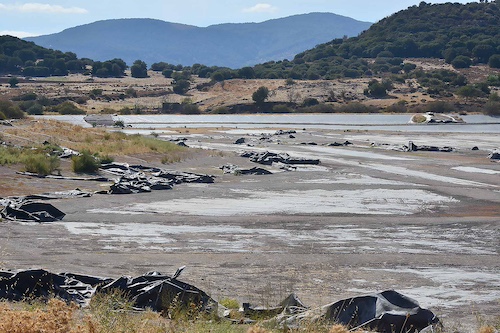(The deserted water reservoir near Molyvos)
We are half way through October and still no significant amount of rain has reached the island. Leaves in the trees give a sad impression and the olive trees are so thirsty that they are not sure if they should release their fruit or wait for some rain. The little bit of humidity hanging in the autumnal sky has only brought purple cyclamen and yellow autumn crocus (Sternbergia lutea): giving some colour to the dry landscape.
Lesvos is an island full of water. At least, it was. It has some big rivers that even during this summer maintained wet riverbeds. There are wetlands around Skala Kalloni, Skala Eresou, and Sigri has a wet landscape surrounding the Tapsas river in Faneromeni. There are some lakes, but those are reservoirs constructed for water management: nearby Molyvos, Kalloni, Eresos and the one at the Sedoentas river above Plomari.
Greeks are not great at maintenance. An instance being is the reservoir near Molyvos that has long lost its original purpose and has now surrendered itself to nature, a paradise for birds. The island mainly depends on its many water sources and underground water streams. These however do not have eternal life, especially not now with increasing tourism and climate changes that bring less and less rain to Lesvos.
The drought is marching south to north, also on Lesvos. Last summer the tourist village of Molyvos had serious water shortages and water had to be transported by a wobbly van from a source to a reservoir above the village. This summer the water came via repaired pipes from that same source and the inhabitants and their guests could enjoy plenty of bathing and washing. Progress indeed; however the groundwater level has dramatically sunk.
Lesvos is more an agrarian than a touristic island. It is famous for ouzo, cheese, sardines and it produces high quality olive oil. Farmers are the biggest water consumers but tourists could easily overtake that position. Last summer on some thirsty Greek islands the water that was available was to go to the tourists and farmers could forget about their crops. Also in the touristic north of Lesvos, water sources close to hotels have started to produce less and less water, leaving farmers to organize their own water transport towards their fields and cattle.
To fight the drought the island signed a contract to build another water reservoir: the Tsiknia Dam, to be built somewhere between Petra and Kalloni. This is to provide water for the capital Mytilini and the region surrounding Kalloni. Cost: 98 million euro.
No good news for the birds that hang around in the wetlands of Kalloni — nor for the fish and other living souls in the Gulf of Kalloni that have to be prepared for changes. Because no serious research has investigated what else the dam can produce. Environmental groups are afraid that this big intervention in nature may dry out or salinate the watery fields, so popular with birdwatchers, surrounding Skala Kalloni. There is not even a guarantee that the reservoir (due to climate change) will ever fill with water.
Lesvos sprinkles asphalt over its roads like it is salt for slippery winter roads, even over the walking paths beloved by tourists. But the road towards the most touristic area of the island, the Kalloni – Petra road, retains its curvy self, unlike so many other roads that have been renewed, like the Kalloni – Sigri road, that endured a fifteen years’ adventure to transform into a smooth running new road. I must admit: a super improvement for a small amount of people on the island. However, the friendly little Sigri with its white houses and its new harbour (for a ferry that moors there only twelve Saturdays per summer), is not the touristic capital of Lesvos (that is Molyvos).
But again millions will get spent for a project that (if it succeeds) would be better elsewhere: the north (and Plomari) urgently needs more water than the capital and Kalloni, especially now that tourism is booming. It looks like there is no vision here on the island: not how to regulate the growing tourism; no vision on where to improve the roads nor a view on water management. To forbid showering on the beaches (yet not shut off the water there!), to forbid washing of cars or refilling private pools is no solution, especially at the very end of the summer.











